Copyright Law Analysis: Infringement and Legal Implications
VerifiedAdded on 2020/04/21
|7
|1142
|92
Homework Assignment
AI Summary
This assignment delves into the intricacies of copyright law within the Australian context. It begins by defining copyright, explaining its scope, and outlining the protection afforded to various forms of creative expression, including literary, dramatic, artistic, and musical works, as well as software and data compilations. The assignment then presents and analyzes several case studies involving copyright infringement. The first case examines whether an individual has rights in cases of copyright infringement. The second case explores the liability of a restaurant owner who plays copyrighted music in their establishment. The third case investigates whether an artist can stop others from using his work. The assignment references relevant legislation, including the Copyright Act 1968, and provides legal analysis of the issues, rules, and applications within each case, concluding with judgments based on the presented facts and legal principles. The references at the end include relevant case law and academic sources to support the analysis.
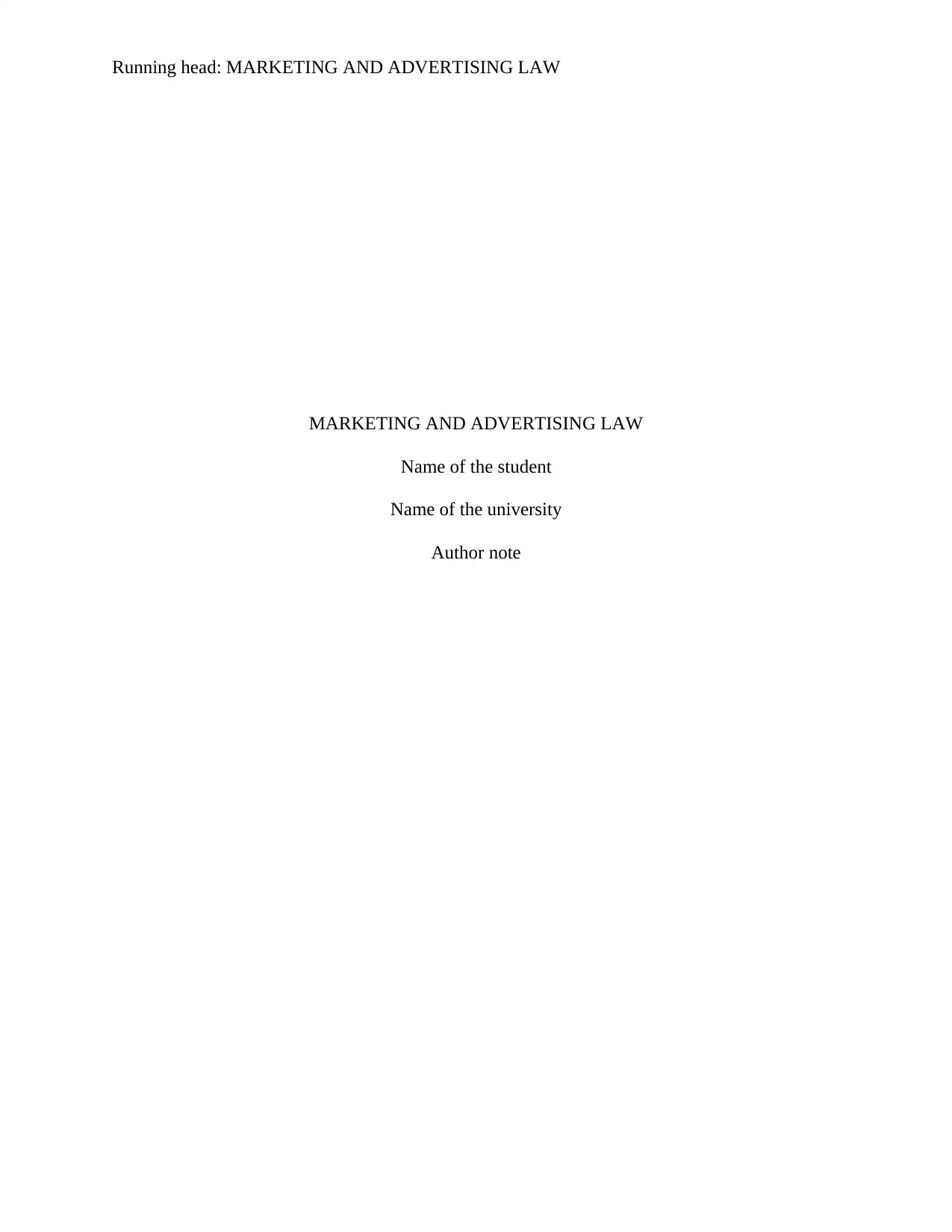
Running head: MARKETING AND ADVERTISING LAW
MARKETING AND ADVERTISING LAW
Name of the student
Name of the university
Author note
MARKETING AND ADVERTISING LAW
Name of the student
Name of the university
Author note
Paraphrase This Document
Need a fresh take? Get an instant paraphrase of this document with our AI Paraphraser
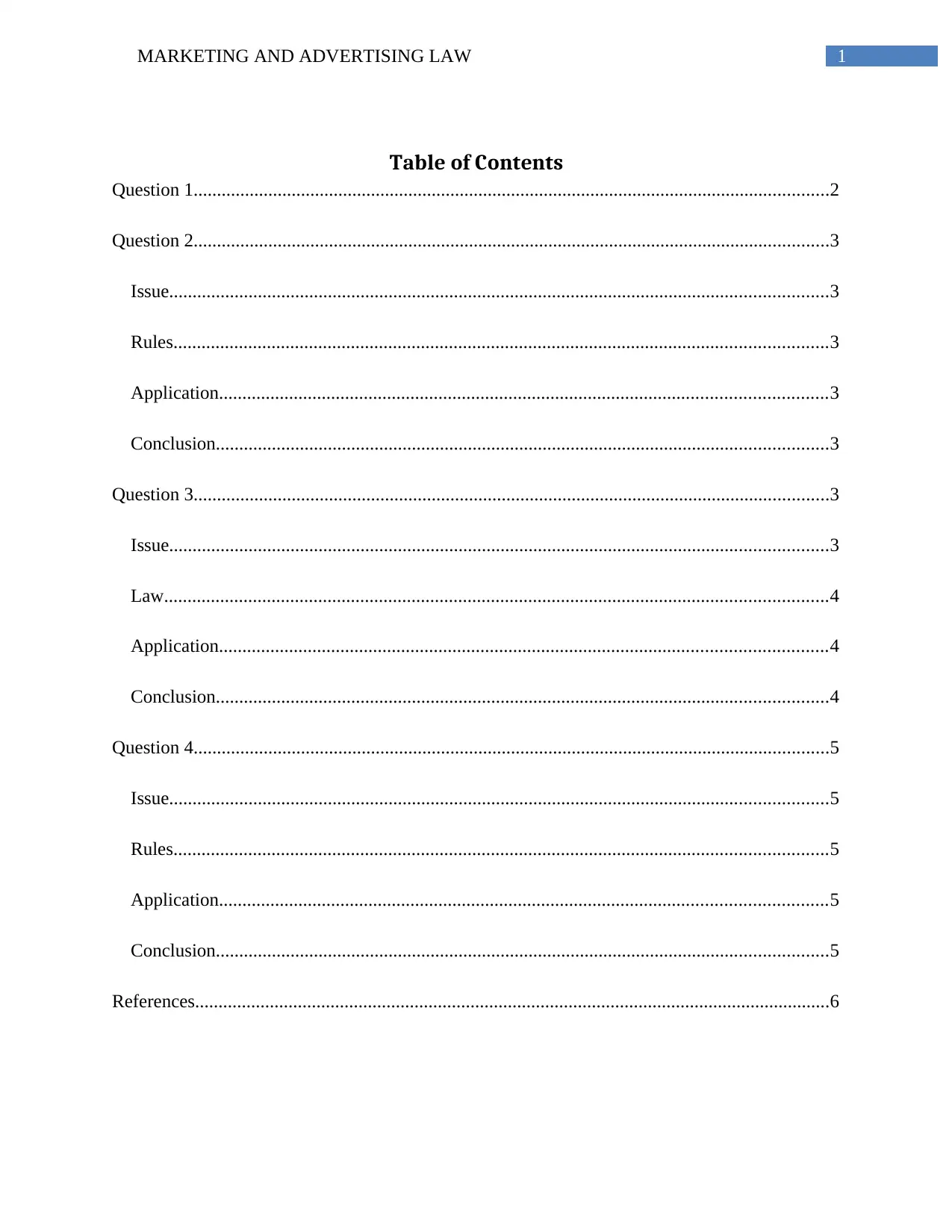
1MARKETING AND ADVERTISING LAW
Table of Contents
Question 1........................................................................................................................................2
Question 2........................................................................................................................................3
Issue.............................................................................................................................................3
Rules............................................................................................................................................3
Application..................................................................................................................................3
Conclusion...................................................................................................................................3
Question 3........................................................................................................................................3
Issue.............................................................................................................................................3
Law..............................................................................................................................................4
Application..................................................................................................................................4
Conclusion...................................................................................................................................4
Question 4........................................................................................................................................5
Issue.............................................................................................................................................5
Rules............................................................................................................................................5
Application..................................................................................................................................5
Conclusion...................................................................................................................................5
References........................................................................................................................................6
Table of Contents
Question 1........................................................................................................................................2
Question 2........................................................................................................................................3
Issue.............................................................................................................................................3
Rules............................................................................................................................................3
Application..................................................................................................................................3
Conclusion...................................................................................................................................3
Question 3........................................................................................................................................3
Issue.............................................................................................................................................3
Law..............................................................................................................................................4
Application..................................................................................................................................4
Conclusion...................................................................................................................................4
Question 4........................................................................................................................................5
Issue.............................................................................................................................................5
Rules............................................................................................................................................5
Application..................................................................................................................................5
Conclusion...................................................................................................................................5
References........................................................................................................................................6
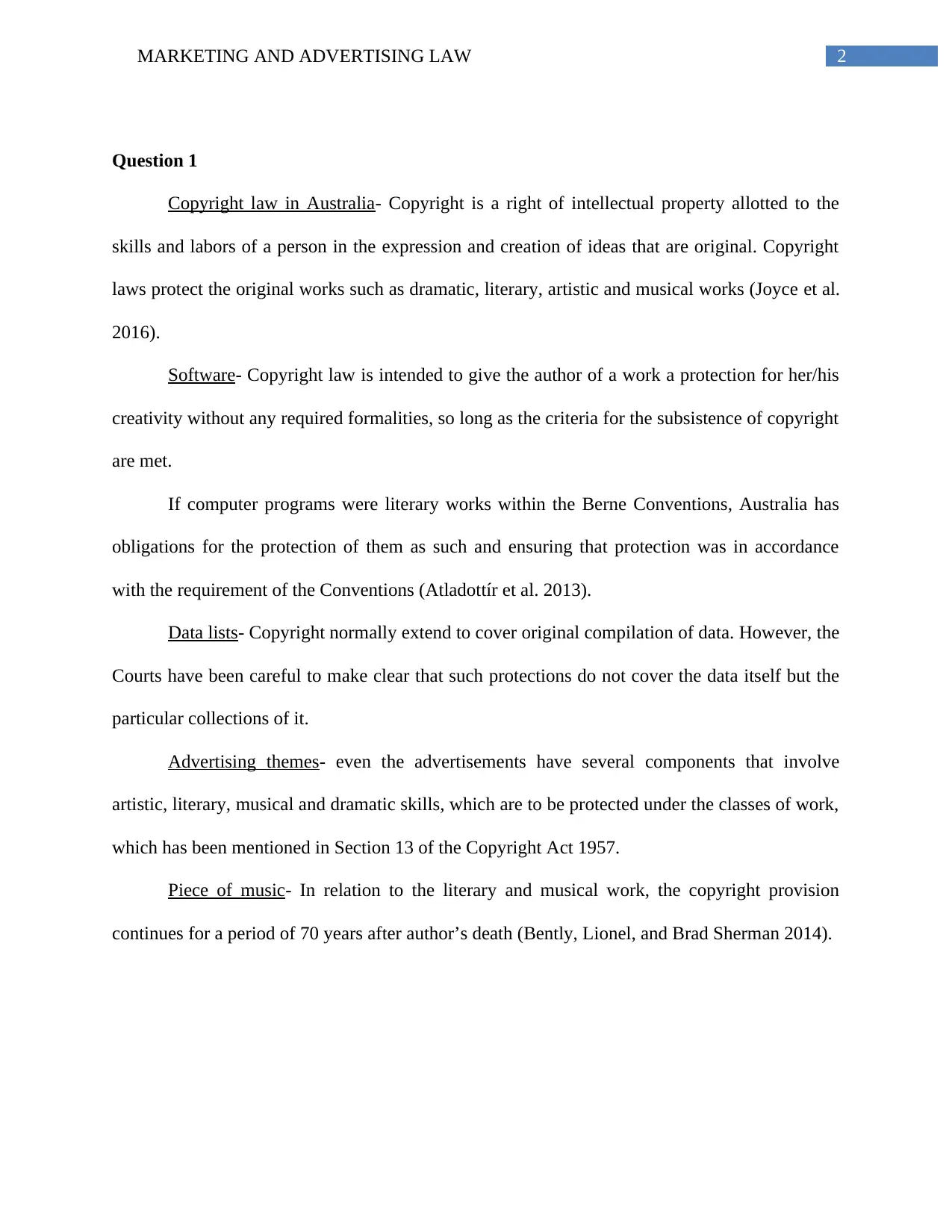
2MARKETING AND ADVERTISING LAW
Question 1
Copyright law in Australia- Copyright is a right of intellectual property allotted to the
skills and labors of a person in the expression and creation of ideas that are original. Copyright
laws protect the original works such as dramatic, literary, artistic and musical works (Joyce et al.
2016).
Software- Copyright law is intended to give the author of a work a protection for her/his
creativity without any required formalities, so long as the criteria for the subsistence of copyright
are met.
If computer programs were literary works within the Berne Conventions, Australia has
obligations for the protection of them as such and ensuring that protection was in accordance
with the requirement of the Conventions (Atladottír et al. 2013).
Data lists- Copyright normally extend to cover original compilation of data. However, the
Courts have been careful to make clear that such protections do not cover the data itself but the
particular collections of it.
Advertising themes- even the advertisements have several components that involve
artistic, literary, musical and dramatic skills, which are to be protected under the classes of work,
which has been mentioned in Section 13 of the Copyright Act 1957.
Piece of music- In relation to the literary and musical work, the copyright provision
continues for a period of 70 years after author’s death (Bently, Lionel, and Brad Sherman 2014).
Question 1
Copyright law in Australia- Copyright is a right of intellectual property allotted to the
skills and labors of a person in the expression and creation of ideas that are original. Copyright
laws protect the original works such as dramatic, literary, artistic and musical works (Joyce et al.
2016).
Software- Copyright law is intended to give the author of a work a protection for her/his
creativity without any required formalities, so long as the criteria for the subsistence of copyright
are met.
If computer programs were literary works within the Berne Conventions, Australia has
obligations for the protection of them as such and ensuring that protection was in accordance
with the requirement of the Conventions (Atladottír et al. 2013).
Data lists- Copyright normally extend to cover original compilation of data. However, the
Courts have been careful to make clear that such protections do not cover the data itself but the
particular collections of it.
Advertising themes- even the advertisements have several components that involve
artistic, literary, musical and dramatic skills, which are to be protected under the classes of work,
which has been mentioned in Section 13 of the Copyright Act 1957.
Piece of music- In relation to the literary and musical work, the copyright provision
continues for a period of 70 years after author’s death (Bently, Lionel, and Brad Sherman 2014).
⊘ This is a preview!⊘
Do you want full access?
Subscribe today to unlock all pages.

Trusted by 1+ million students worldwide
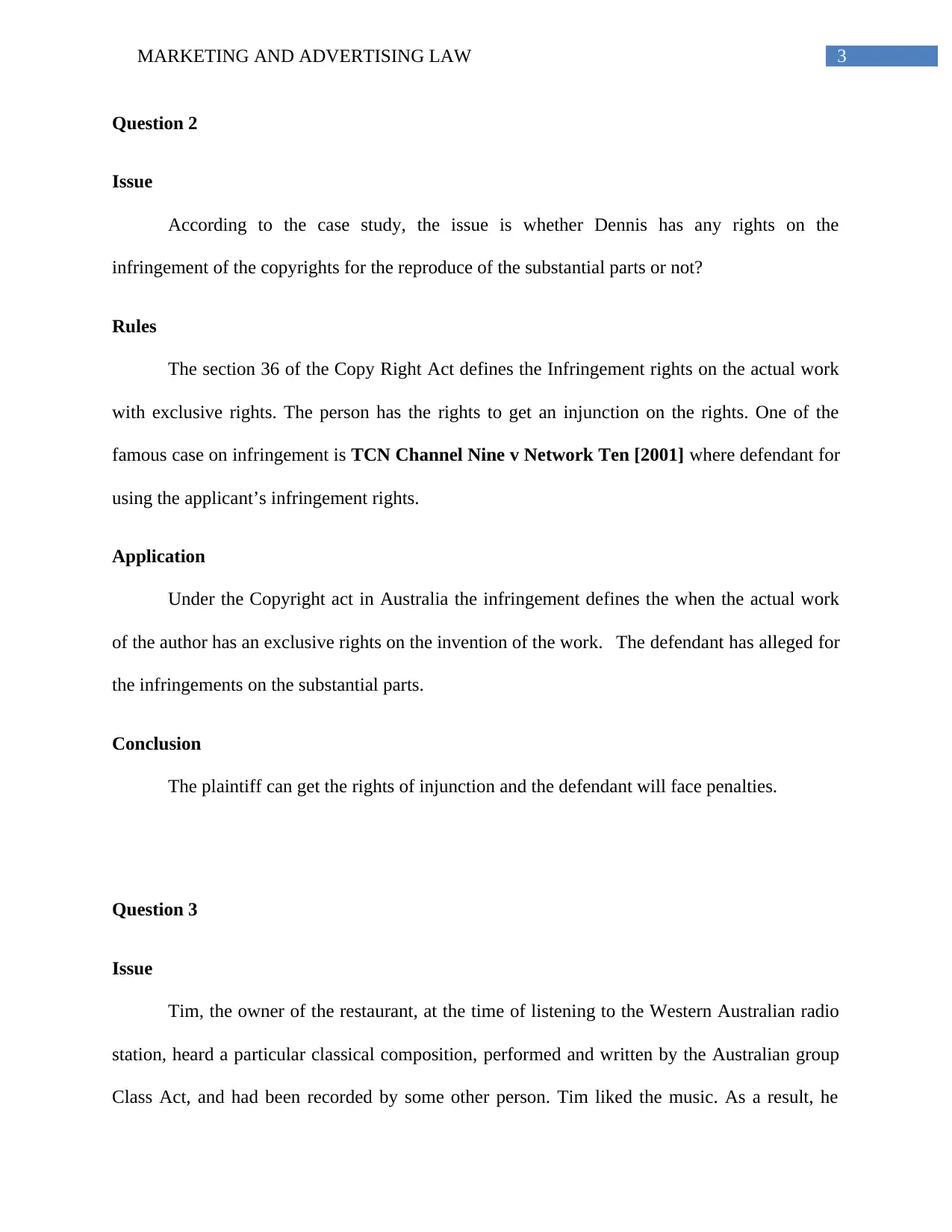
3MARKETING AND ADVERTISING LAW
Question 2
Issue
According to the case study, the issue is whether Dennis has any rights on the
infringement of the copyrights for the reproduce of the substantial parts or not?
Rules
The section 36 of the Copy Right Act defines the Infringement rights on the actual work
with exclusive rights. The person has the rights to get an injunction on the rights. One of the
famous case on infringement is TCN Channel Nine v Network Ten [2001] where defendant for
using the applicant’s infringement rights.
Application
Under the Copyright act in Australia the infringement defines the when the actual work
of the author has an exclusive rights on the invention of the work. The defendant has alleged for
the infringements on the substantial parts.
Conclusion
The plaintiff can get the rights of injunction and the defendant will face penalties.
Question 3
Issue
Tim, the owner of the restaurant, at the time of listening to the Western Australian radio
station, heard a particular classical composition, performed and written by the Australian group
Class Act, and had been recorded by some other person. Tim liked the music. As a result, he
Question 2
Issue
According to the case study, the issue is whether Dennis has any rights on the
infringement of the copyrights for the reproduce of the substantial parts or not?
Rules
The section 36 of the Copy Right Act defines the Infringement rights on the actual work
with exclusive rights. The person has the rights to get an injunction on the rights. One of the
famous case on infringement is TCN Channel Nine v Network Ten [2001] where defendant for
using the applicant’s infringement rights.
Application
Under the Copyright act in Australia the infringement defines the when the actual work
of the author has an exclusive rights on the invention of the work. The defendant has alleged for
the infringements on the substantial parts.
Conclusion
The plaintiff can get the rights of injunction and the defendant will face penalties.
Question 3
Issue
Tim, the owner of the restaurant, at the time of listening to the Western Australian radio
station, heard a particular classical composition, performed and written by the Australian group
Class Act, and had been recorded by some other person. Tim liked the music. As a result, he
Paraphrase This Document
Need a fresh take? Get an instant paraphrase of this document with our AI Paraphraser
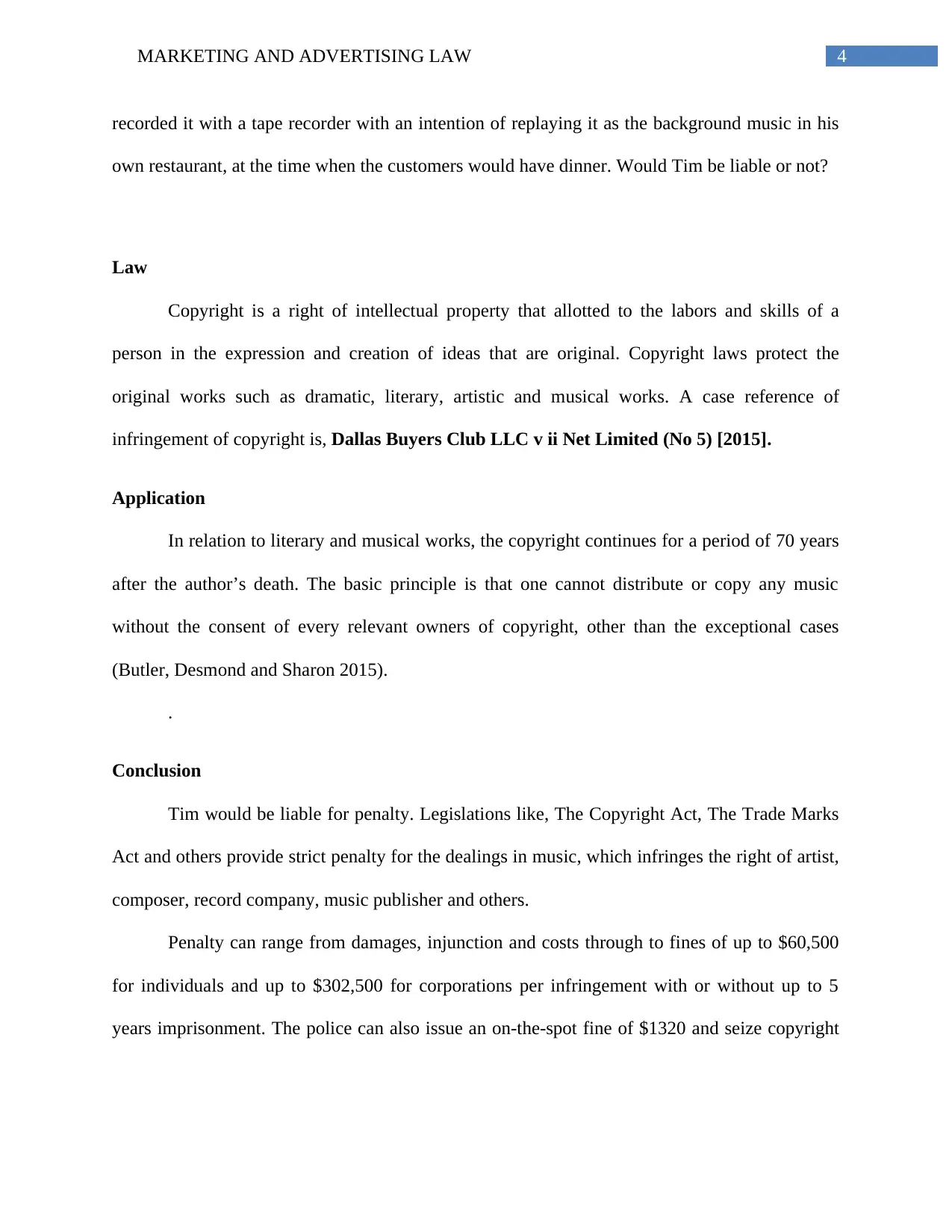
4MARKETING AND ADVERTISING LAW
recorded it with a tape recorder with an intention of replaying it as the background music in his
own restaurant, at the time when the customers would have dinner. Would Tim be liable or not?
Law
Copyright is a right of intellectual property that allotted to the labors and skills of a
person in the expression and creation of ideas that are original. Copyright laws protect the
original works such as dramatic, literary, artistic and musical works. A case reference of
infringement of copyright is, Dallas Buyers Club LLC v ii Net Limited (No 5) [2015].
Application
In relation to literary and musical works, the copyright continues for a period of 70 years
after the author’s death. The basic principle is that one cannot distribute or copy any music
without the consent of every relevant owners of copyright, other than the exceptional cases
(Butler, Desmond and Sharon 2015).
.
Conclusion
Tim would be liable for penalty. Legislations like, The Copyright Act, The Trade Marks
Act and others provide strict penalty for the dealings in music, which infringes the right of artist,
composer, record company, music publisher and others.
Penalty can range from damages, injunction and costs through to fines of up to $60,500
for individuals and up to $302,500 for corporations per infringement with or without up to 5
years imprisonment. The police can also issue an on-the-spot fine of $1320 and seize copyright
recorded it with a tape recorder with an intention of replaying it as the background music in his
own restaurant, at the time when the customers would have dinner. Would Tim be liable or not?
Law
Copyright is a right of intellectual property that allotted to the labors and skills of a
person in the expression and creation of ideas that are original. Copyright laws protect the
original works such as dramatic, literary, artistic and musical works. A case reference of
infringement of copyright is, Dallas Buyers Club LLC v ii Net Limited (No 5) [2015].
Application
In relation to literary and musical works, the copyright continues for a period of 70 years
after the author’s death. The basic principle is that one cannot distribute or copy any music
without the consent of every relevant owners of copyright, other than the exceptional cases
(Butler, Desmond and Sharon 2015).
.
Conclusion
Tim would be liable for penalty. Legislations like, The Copyright Act, The Trade Marks
Act and others provide strict penalty for the dealings in music, which infringes the right of artist,
composer, record company, music publisher and others.
Penalty can range from damages, injunction and costs through to fines of up to $60,500
for individuals and up to $302,500 for corporations per infringement with or without up to 5
years imprisonment. The police can also issue an on-the-spot fine of $1320 and seize copyright
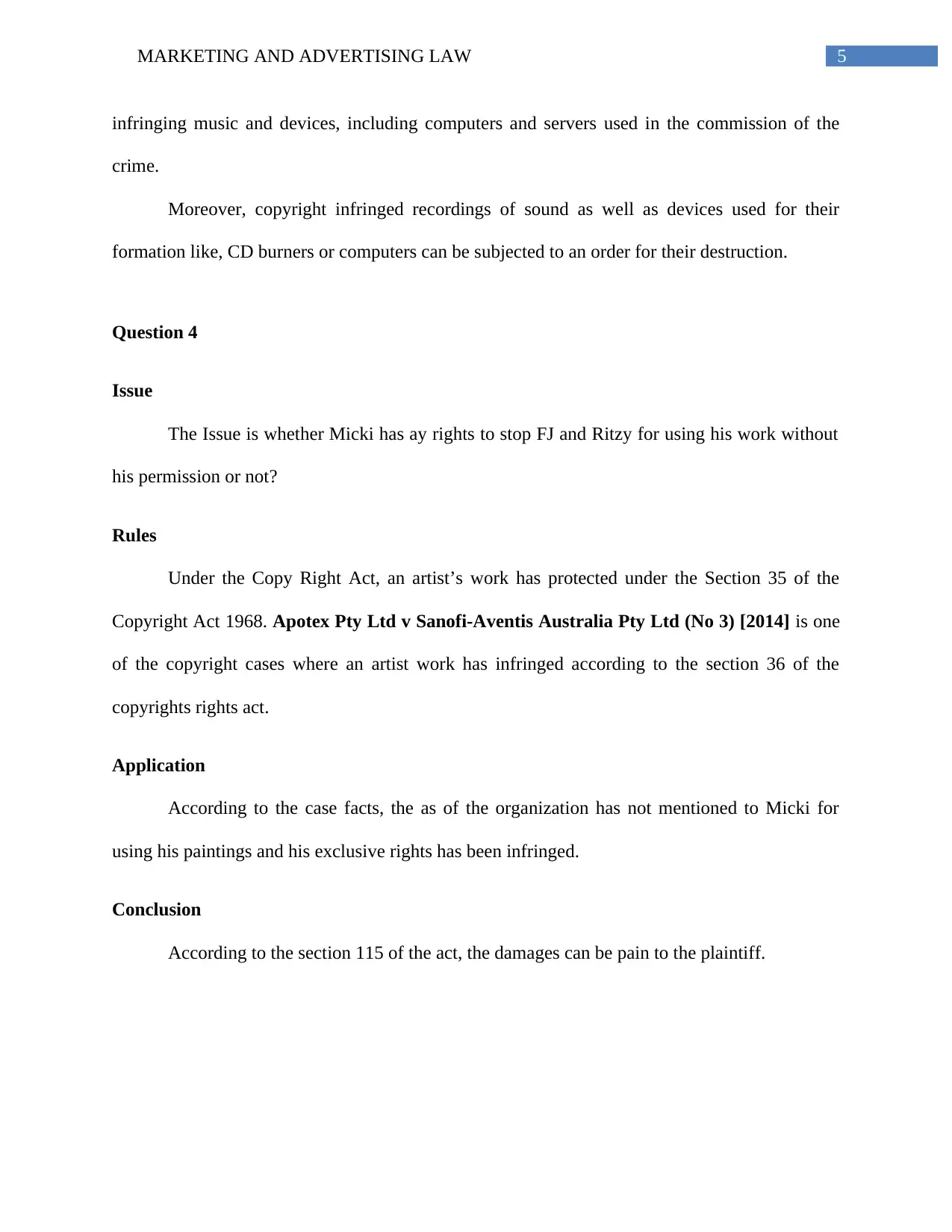
5MARKETING AND ADVERTISING LAW
infringing music and devices, including computers and servers used in the commission of the
crime.
Moreover, copyright infringed recordings of sound as well as devices used for their
formation like, CD burners or computers can be subjected to an order for their destruction.
Question 4
Issue
The Issue is whether Micki has ay rights to stop FJ and Ritzy for using his work without
his permission or not?
Rules
Under the Copy Right Act, an artist’s work has protected under the Section 35 of the
Copyright Act 1968. Apotex Pty Ltd v Sanofi-Aventis Australia Pty Ltd (No 3) [2014] is one
of the copyright cases where an artist work has infringed according to the section 36 of the
copyrights rights act.
Application
According to the case facts, the as of the organization has not mentioned to Micki for
using his paintings and his exclusive rights has been infringed.
Conclusion
According to the section 115 of the act, the damages can be pain to the plaintiff.
infringing music and devices, including computers and servers used in the commission of the
crime.
Moreover, copyright infringed recordings of sound as well as devices used for their
formation like, CD burners or computers can be subjected to an order for their destruction.
Question 4
Issue
The Issue is whether Micki has ay rights to stop FJ and Ritzy for using his work without
his permission or not?
Rules
Under the Copy Right Act, an artist’s work has protected under the Section 35 of the
Copyright Act 1968. Apotex Pty Ltd v Sanofi-Aventis Australia Pty Ltd (No 3) [2014] is one
of the copyright cases where an artist work has infringed according to the section 36 of the
copyrights rights act.
Application
According to the case facts, the as of the organization has not mentioned to Micki for
using his paintings and his exclusive rights has been infringed.
Conclusion
According to the section 115 of the act, the damages can be pain to the plaintiff.
⊘ This is a preview!⊘
Do you want full access?
Subscribe today to unlock all pages.

Trusted by 1+ million students worldwide
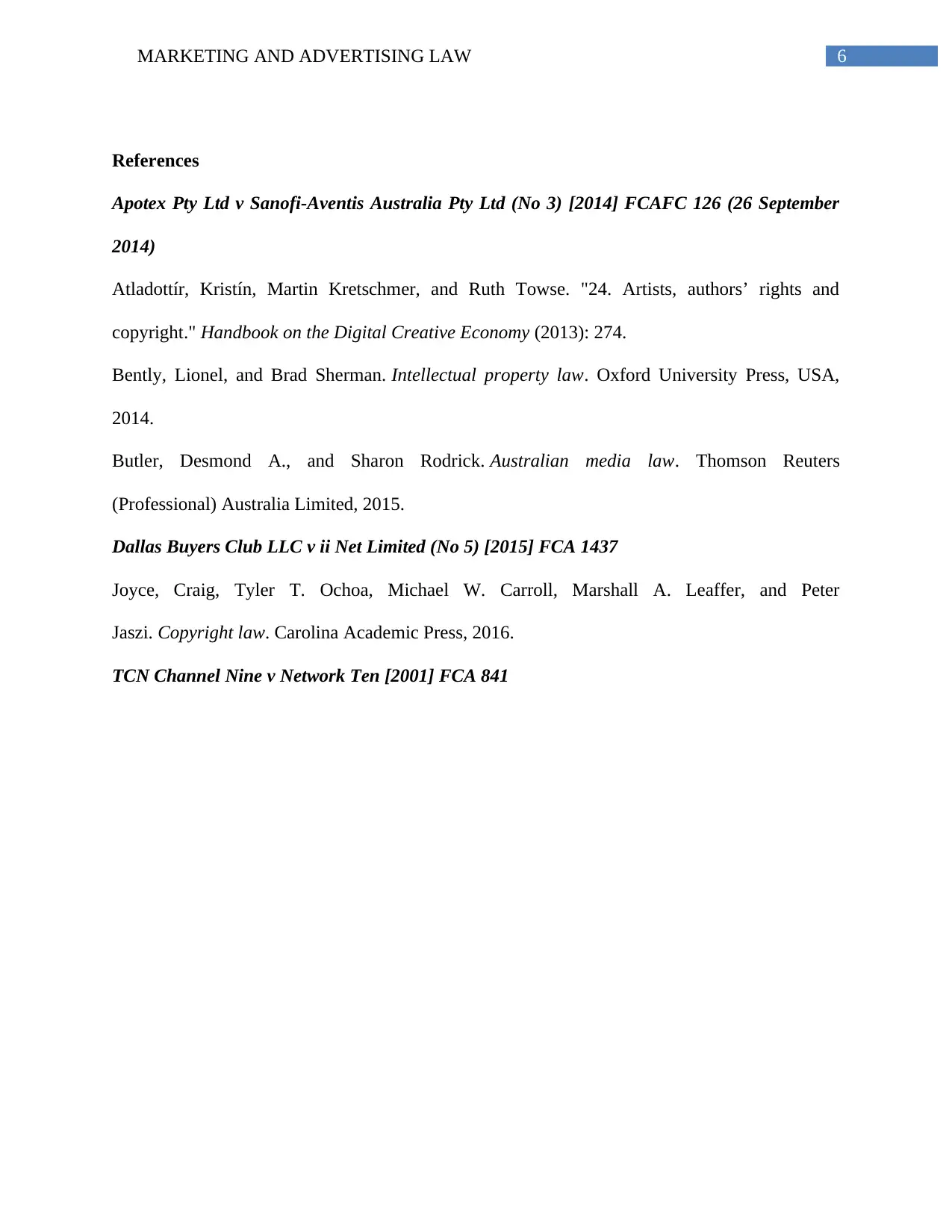
6MARKETING AND ADVERTISING LAW
References
Apotex Pty Ltd v Sanofi-Aventis Australia Pty Ltd (No 3) [2014] FCAFC 126 (26 September
2014)
Atladottír, Kristín, Martin Kretschmer, and Ruth Towse. "24. Artists, authors’ rights and
copyright." Handbook on the Digital Creative Economy (2013): 274.
Bently, Lionel, and Brad Sherman. Intellectual property law. Oxford University Press, USA,
2014.
Butler, Desmond A., and Sharon Rodrick. Australian media law. Thomson Reuters
(Professional) Australia Limited, 2015.
Dallas Buyers Club LLC v ii Net Limited (No 5) [2015] FCA 1437
Joyce, Craig, Tyler T. Ochoa, Michael W. Carroll, Marshall A. Leaffer, and Peter
Jaszi. Copyright law. Carolina Academic Press, 2016.
TCN Channel Nine v Network Ten [2001] FCA 841
References
Apotex Pty Ltd v Sanofi-Aventis Australia Pty Ltd (No 3) [2014] FCAFC 126 (26 September
2014)
Atladottír, Kristín, Martin Kretschmer, and Ruth Towse. "24. Artists, authors’ rights and
copyright." Handbook on the Digital Creative Economy (2013): 274.
Bently, Lionel, and Brad Sherman. Intellectual property law. Oxford University Press, USA,
2014.
Butler, Desmond A., and Sharon Rodrick. Australian media law. Thomson Reuters
(Professional) Australia Limited, 2015.
Dallas Buyers Club LLC v ii Net Limited (No 5) [2015] FCA 1437
Joyce, Craig, Tyler T. Ochoa, Michael W. Carroll, Marshall A. Leaffer, and Peter
Jaszi. Copyright law. Carolina Academic Press, 2016.
TCN Channel Nine v Network Ten [2001] FCA 841
1 out of 7
Related Documents
Your All-in-One AI-Powered Toolkit for Academic Success.
+13062052269
info@desklib.com
Available 24*7 on WhatsApp / Email
![[object Object]](/_next/static/media/star-bottom.7253800d.svg)
Unlock your academic potential
Copyright © 2020–2025 A2Z Services. All Rights Reserved. Developed and managed by ZUCOL.





